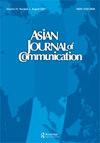Minority ethnic media: challenges for the future
IF 1.5
2区 文学
Q2 COMMUNICATION
引用次数: 0
Abstract
ABSTRACT Minority ethnic media play a unique role in preserving the languages, shaping the identity, and improving communication and cohesion of the ethnic groups it represents. However, traditional ethnic media outlets such as television channels and printed media worldwide have been facing decreasing viewership, especially because of strong competition from Internet media. Obtaining the support of people in the targeted ethnic group is critical and challenging. This paper elucidates the obstacles—dwindling viewership, competition from new media, and debates on intragroup and intergroup (intercultural) communication—that minority ethnic television channels face in many societies. By using the Taiwanese minority ethnic channel Hakka TV as an example, this study examined audiences’ viewing behaviors with respect to both the terrestrial channel and its online platform. A National Survey on Hakka Population and Languages (supported by the Taiwan Hakka Affairs Council) and in-depth interviews were used to explore the relationships between ethnicity, language, and communication in ethnic media. The results indicate what ethnic media outlets should prioritize to increasing viewership. Methods by which these outlets can reach out to other ethnic groups and enhance multiculturalism are discussed.少数民族媒体:未来的挑战
摘要少数民族媒体在保护语言、塑造身份、提高所代表民族的沟通和凝聚力方面发挥着独特的作用。然而,世界各地的电视频道和印刷媒体等传统民族媒体的收视率一直在下降,特别是因为来自互联网媒体的激烈竞争。获得目标族裔群体的支持至关重要,也具有挑战性。本文阐述了少数民族电视频道在许多社会中面临的障碍——收视率下降、新媒体的竞争以及关于群体内和群体间(跨文化)沟通的辩论。以台湾少数民族频道客家电视台为例,研究了观众对地面频道及其网络平台的观看行为。通过台湾客务委员会支持的全国客家人口与语言调查和深入访谈,探讨了族群、语言和民族媒体传播之间的关系。研究结果表明,少数民族媒体应该优先考虑增加收视率。讨论了这些渠道接触其他族裔群体和加强多元文化的方法。
本文章由计算机程序翻译,如有差异,请以英文原文为准。
求助全文
约1分钟内获得全文
求助全文
来源期刊

Asian Journal of Communication
COMMUNICATION-
CiteScore
3.70
自引率
0.00%
发文量
38
期刊介绍:
Launched in 1990, Asian Journal of Communication (AJC) is a refereed international publication that provides a venue for high-quality communication scholarship with an Asian focus and perspectives from the region. We aim to highlight research on the systems and processes of communication in the Asia-Pacific region and among Asian communities around the world to a wide international audience. It publishes articles that report empirical studies, develop communication theory, and enhance research methodology. AJC is accepted by and listed in the Social Science Citation Index (SSCI) published by Clarivate Analytics. The journal is housed editorially at the Wee Kim Wee School of Communication and Information at Nanyang Technological University in Singapore, jointly with the Asian Media Information and Communication Centre (AMIC).
 求助内容:
求助内容: 应助结果提醒方式:
应助结果提醒方式:


